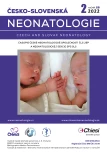Hyperbilirubinemia – time for change?
Authors:
I. Bodnarová 1,2; A. Staníková 3
Authors‘ workplace:
Ústav pro péči o matku a dítě, Praha
1; The Coombe Womans Hospital, Dublin
2; FN Brno
3
Published in:
Čes-slov Neonat 2022; 28 (2): 100-106.
Category:
Reviews
Overview
Jaundice is one of the most frequent problem in neonatal wards, it affects up to 60 % term infants and 80 % of premature infants. The high prevalence of neonatal hyperbilirubinemia is caused by an imbalance favoring the production of bilirubin over its elimination. The main goal of treatment for neonatal jaundice is the prevention of permanent brain damage while simultaneously minimizing invasive examinations and excessive use of phototherapy. This article includes the current recommendation for the management of hyperbilirubinemia in newborns of more than 35 weeks of gestation, which was issued by the American Pediatric Association in 2022.
Keywords:
phototherapy – hyperbilirubinemia – icterus
Sources
1. Wang J, Guo G, Li A, et al. Challenges of phototherapy for neonatal hyperbilirubinemia (review). Exp Ther Med 2021; 21(3): 231.
2. Flaherman VJ, Maisels MJ, Brodribb W, et al. ABM Clinical Protocol #22: Guidelines for management of jaundice in the breastfeeding infant 35 weeks or more of gestation. Breastfeeding Medicine 2017; 12(5): 250–257.
3. Bahr TM, Henry E, Christensen RD, et al. A new hour-specific serum bilirubin nomogram for neonates ≥ 35 weeks of gestation. J Pediatr 2021; 236: 28–33.e1.
4. Lauer BJ, Spector ND. Hyperbilirubinemia in the newborn. Pediatr Rev 2011; 32(8): 341–349.
5. Neonatal Jaundice. National Institute of Child Health and Clinical Excellence, 2011. Dostupné na: http://pathways.nice.org.uk/ pathways/neonatal-jaundice.
6. Kemper AR, Newman TB, Slaughter JL, et al. Clinical practice guideline revision: management of hyperbilirubinemia in the newborn infant 35 or more weeks of gestation. Pediatrics 2022; 150(3): e2022058859.
7. Watchko J. Recent advances in the management of neonatal jaundice. Res Rep Neonatol 2014; 4: 183–193.
8. Olusanya BO, Kaplan M, Hansen TWR. Neonatal hyperbilirubinaemia: a global perspective. Lancet Child Adolesc Health 2018; 2(8): 610–620.
9. Maisels MJ. Managing the jaundiced newborn: a persistent challenge. Can Med Assoc J 2014; 187(5): 335–343.
10. Maisels MJ, Bhutani VK, Bogen D, et al. Hyperbilirubinemia in the newborn infant ≥ 35 weeks’ gestation: an update with clarifications. Pediatrics 2009; 124(4): 1193–1198.
11. American Academy of Pediatrics, Subcommittee on Hyperbilirubinemia. Management of hyperbilirubinemia in the newborn infant 35 or more weeks of gestation. Pediatrics 2004; 114(1): 297–316.
12. Taylor JA, Burgos AE, Flaherman V, et al. Discrepancies between transcutaneous and serum bilirubin measurements. Pediatrics 2005; 135(2): 224–231.
13. Bhutani VK. Phototherapy to prevent severe neonatal hyperbilirubinemia in the newborn infant 35 or more weeks of gestation. Pediatrics 2011; 128(4): e1046–e1052.
14. Shinwell ES, Sciaky Y, Karplus M. Effect of position changing on bilirubin levels during phototherapy. J Perinatol 2002; 22(3): 226–229.
15. Shekeeb SM, Kumar P, Sharma N, et al. Evaluation of oxidant and antioxidant status in term neonates: a plausible protective role of bilirubin. Mol Cell Biochem 2008; 317(1–2): 51–59.
16. Chang PW, Newman TB. A simpler prediction rule for rebound hyperbilirubinemia. Pediatrics 2019; 144(1): e20183712 .
17. Grabenhenrich J, Grabenhenrich L, Buhrer C, et al. Transcutaneous bilirubin after phototherapy in term and preterm infants. Pediatrics 2014; 134(5): e1324–e1329.
18. Newman TB, Wu YW, Kuzniewicz MW, et al. Childhood seizures after phototherapy. Pediatrics 2018; 142(4): e20180648.
19. Mehta S, Kumar P, Narang A. A randomized controlled trial of fluid supplementation in term neonates with severe hyperbilirubinemia. J Pediatr 2005; 147(6): 781–785.
20. Zwiers C, Scheffer-Rath MEA, Lopriore E, et al. Immunoglobulin for alloimmune hemolytic disease in neonates. Cochrane Database Syst Rev 2018; 3: CD003313.
Labels
Neonatology Neonatal NurseArticle was published in
Czech and Slovak Neonatology

2022 Issue 2
Most read in this issue
- Hyperbilirubinemia – time for change?
- Screening of the neonatal glycemia and its pitfalls
- Weight loss in breastfed full-term newborns
- Streptococcus agalactiae infections in a newborn
